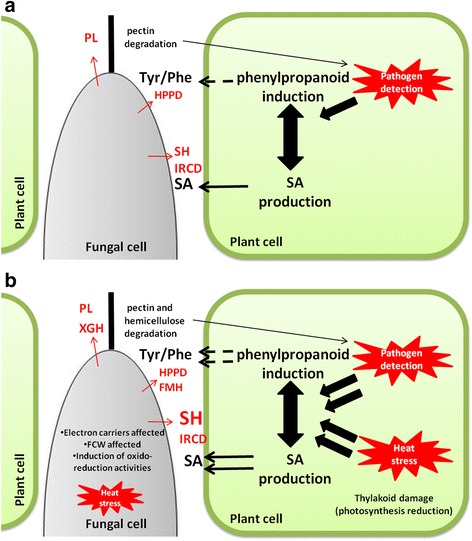Fig. 10.

Proposed model of fungal-plant interaction under heat stress (HS). The model was done using gathered information of in vitro L. theobromae HS global transcriptional response, gene expression in planta (Fig. 7) and documented HS response in plant. a When fungus infects unstressed plant, selectively degrades pectin (up-regulation of PL compared with the other PCWDEs), this allows it to growth in intercellular spaces without causing major damage to PCW. The presence of the pathogen could trigger the host defensive mechanism mediated through SA, or by the activation of the phenylpropanoid pathway. However, the host defense could be impaired for the activity of SH and IRCD (degrade SA), or by HPPD (phenylpropanoid precursors). b Heat stress activates the same metabolic pathways increasing SA and the levels of phenylpropanoid precursors, thus the fungus could benefit from the higher availability of compounds using them as carbon sources. The main differential change on stressed plant, compared with unstressed, is the up-regulation of SH, FMH and XGH, whose activities could facilitate fungal colonization. Tyr: tyrosine. Phe: phenylalanine. SA: salicylic acid, IRCD: intradiol-ring cleavage dioxygenase (comp4276_c0_seq1); SH: salicylate hydroxylase (comp12473_c0_seq1); FMH: fumarylacetoacetate hydrolase (comp14342_c0_seq1); SIT:sugar inositol transporter (comp8181_c0_seq1); PL: pectate lyase (comp16237_c0_seq1). XGH: xylosidase glycoside hydrolase (comp5761_c0_seq2), HPPD: 4- Hydroxyphenylpyruvate dioxygenase (comp18638_c0_seq1). FCW: fungal cell wall. PCW: plant cell wall; PCWDEs: plant cell wall degrading enzymes
